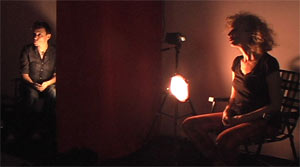The Big Kiss (2007) performed by Annie Abraham. Two people, one of which is Annie Abraham, sit in two separate places in front of a webcam. Their two feeds go onto a screen split down the centre, and they ‘kiss’ each other through this screen. This screen is thus the third space which is discussed in Randall Packer’s ‘Third Space’ (2014). The two people seemed very ‘into’ the kissing, as if they were really in the same first space. This kiss transcends the physical boundaries that they were once restricted by, even though the individuals cannot feel each other physically. Also, their emotions can be felt through the internet kiss.
rather, it is the pervasiveness of distributed space and the degree and myriad of ways in which we are constantly connected.
Interestingly enough, the Big Kiss does reflect a lot of people’s relationships nowadays. Many people now live away from their hometown and leave their love ones, and use internet means to keep in contact with them, no matter whether it is through Facetime, Skype or other platforms that enables us to see and hear each other in real time. We use texting platforms to communicate as well, albeit not exactly in real time so its asynchronous (which gives us the freedom and space to reply at our own pace.) The degree of communication is more intimate in the case of The Big Kiss, as they are forced to face each other in a very intimate (yet at the same time public) space, and not just communicate via their words but through their facial expressions and actions. This may not be the case for everyone who uses the same tools, but it leads us to question whether or not the third space allows the same level of intimacy and communication as the first space.
The penultimate paragraph of Randall Packer’s article pointed out something: that the third space can and may eventually become the new standard in the future. A point to note is the fact that Annie Abraham was born in 1954. She mostly grew up in a time where the internet did not exist. To have to fathom the fact that you can communicate with a person remotely (other than over the telephone) would have been difficult to understand. The increasing use of the internet and the tools that it lends in the 21st century, I imagine, would have been an interesting concept to explore for someone who didn’t rely on it in the past. The third space would have been difficult to understand. Whereas for the millennials, they grow up with the concept of a third space- the millennials don’t need to question how we are able to cross physical boundaries because it’s so commonplace. However, it would still be odd to see people attempting their own rendition of the Big Kiss on their personal devices in public in this day and age. This is probably because it is a very brave act of public display of affection, and would still warrant weird looks from people on the MRT or on the streets if you were to start looking very passionate kissing your phone. In the third space, maybe it would not look that odd, but in real life it would not get a good response from strangers.
This work was very intriguing, and does challenge people’s thoughts about the virtual realm- how does intimacy work virtually, and can it transcend the physical space into the third space? I believe that through this work, we have been able to get some answers to these questions, but I think this concept still requires some smoothening out in my mind to fully comprehend the purpose of the work.


